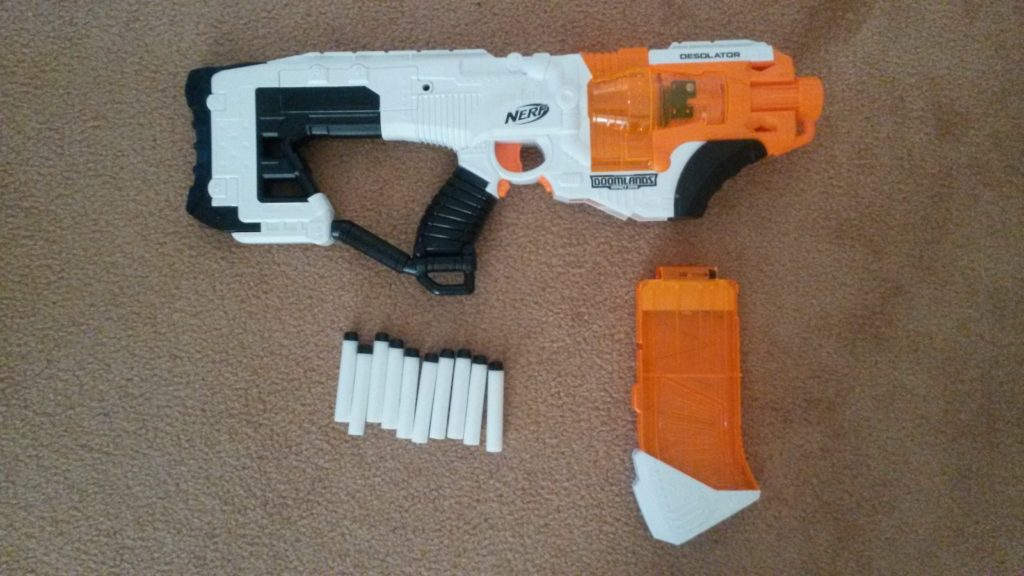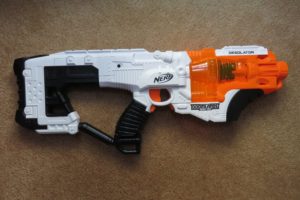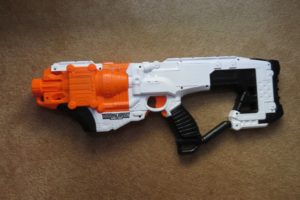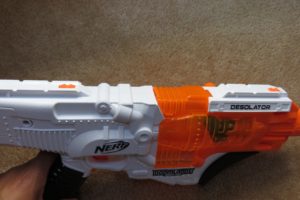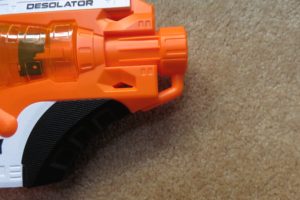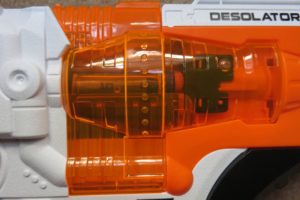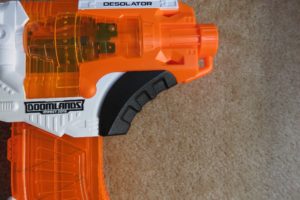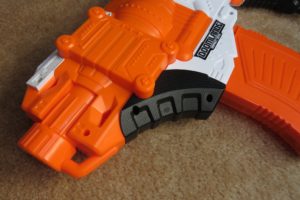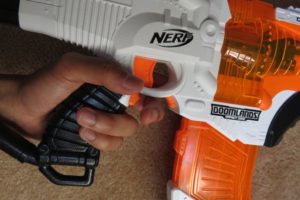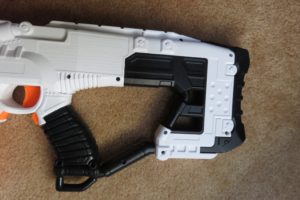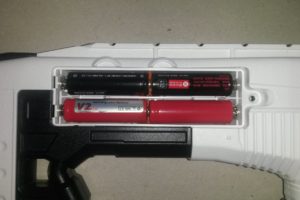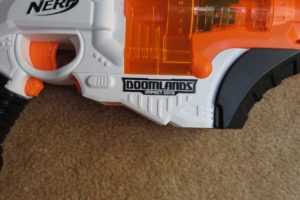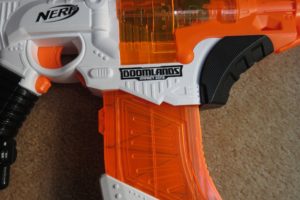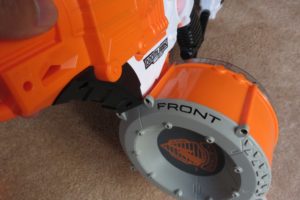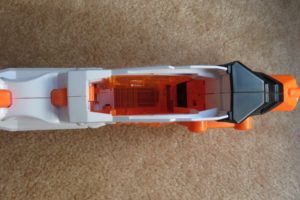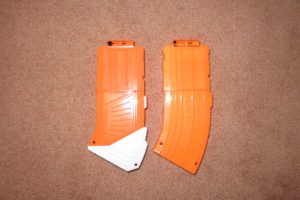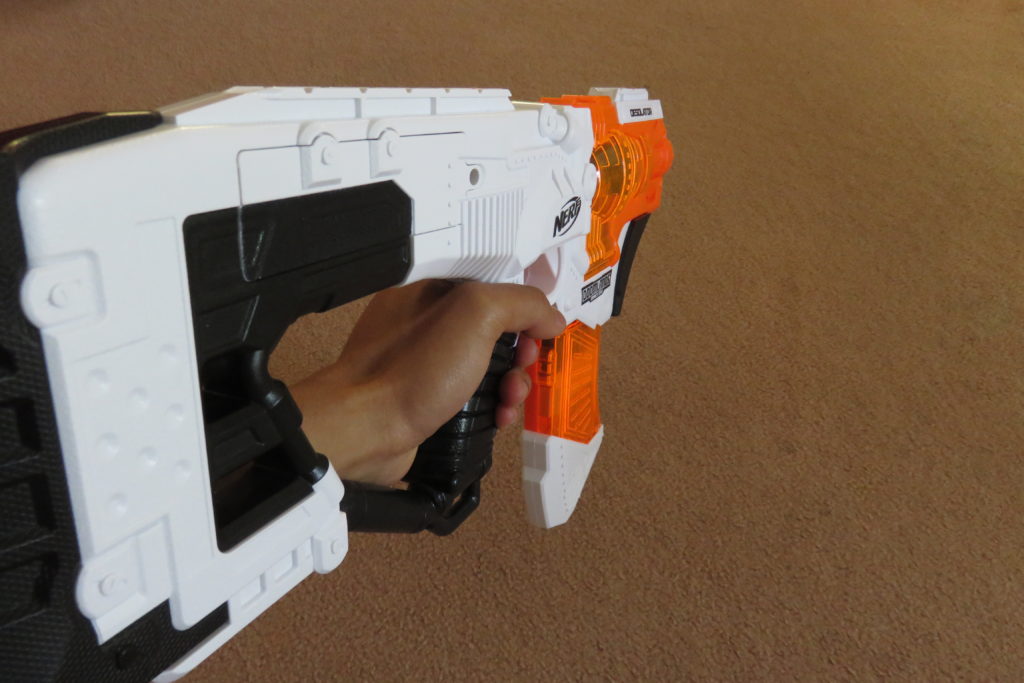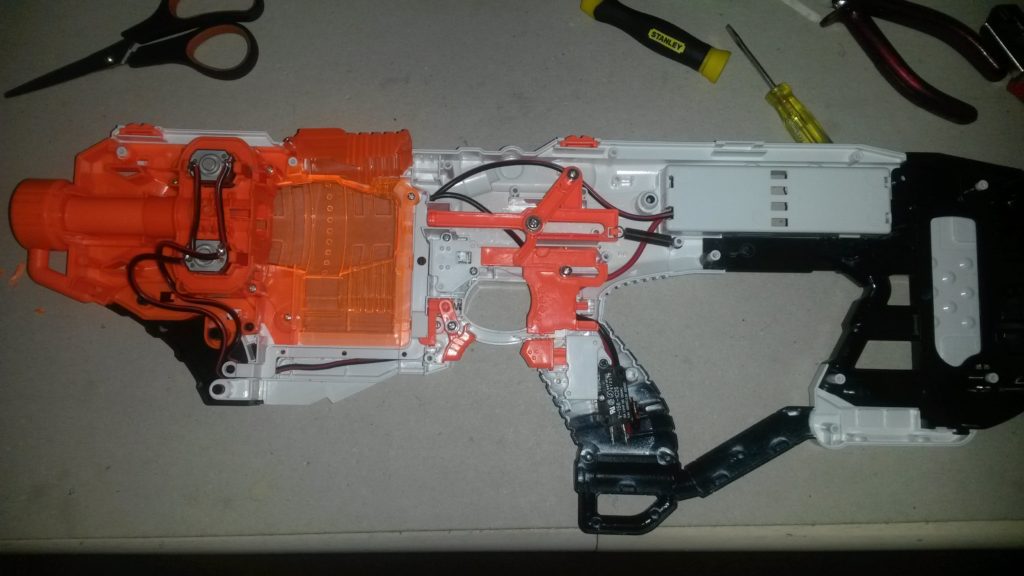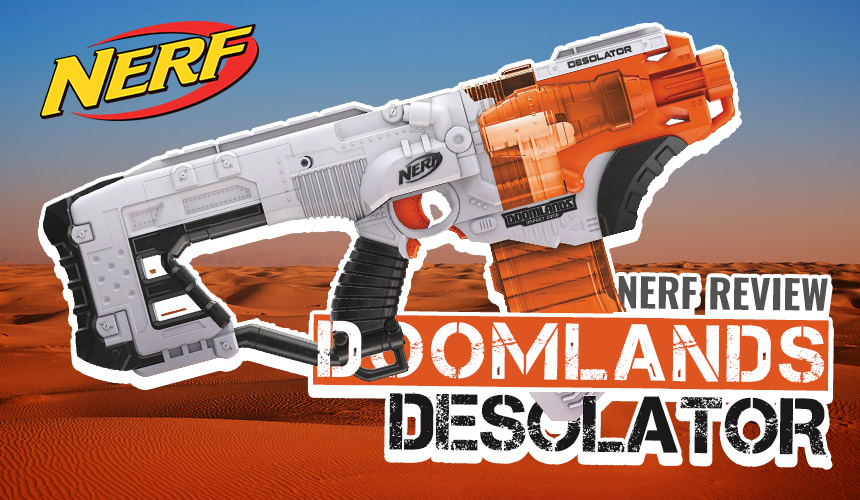

Doomlands Desolator
Nerf
30USD
11-13 metres
5+ darts per second
A fantastic looking and all round solid blaster.
Review: Nerf Doomlands Desolator (US orange trigger)
January 6, 2017The Desolator is one of the blasters in Doomlands’ subtheme, Impact Zone. This subtheme features a primarily white colour scheme, in contrast with regular Doomlands’ primarily yellow/orange colour scheme. The Desolator is often compared to the cheaper and simpler Elite Stryfe, as both are compact semi-auto flywheelers. Being compared to the Stryfe is by no means a bad thing however, as the Stryfe is one of the best and most popular modern blasters. Being compared to a great blaster is one thing, living up to expectations is another. Does the Desolator live up to its expectations?
The Box
Pretty standard open style box, nothing of particular interest here.
The Desolator Blaster
The Desolator is a beautiful, compact blaster. It is packed with all kinds of aesthetic details like texturing on the grips, faux screws and what looks like a fluid pipe system. With the way Nerf’s being cutting back on aesthetic details (I’m looking at you Recon MkII), it’s always nice to see a blaster intricately detailed out-of-box. Like with other Doomlands blasters, the Desolator has a translucent window on one side to show some of the workings of the blaster. In this case it’s a window showing the magwell and the flywheel cage, though unlike with springers there’s very little to see here.
One minor complaint I do have is the inconsistency in width. The bulk of the Desolator is reasonably chunky, and unlike the Stryfe, is symmetrical for the most part. Behind the trigger however, it gets thinner, to the point where the stock appears strangely thin and out of place. It’s by no means flimsy, but it is rather odd.
The foregrip is one of the Desolator’s more distinct features. It’s a smooth, curved piece that is well shaped and textured, and in my opinion is one of the best looking and most comfortable foregrips, with one caveat. The motors in the flywheel cage protude out the left side, so necessitates a protrusion to protect the motors. The box protrusion cuts into the foregrip, in particular the bottom-left cylinder. As a right-hander, this cylinder pokes directly into the palm of my left hand, which is rather irrating and a little uncomfortable. That said, it’s far from the most uncomfortable grip I’ve felt.
The Desolator’s handle uses a unique ribbing design that I personally don’t like. I find the edges to be a little sharp and uncomfortable, certainly more so than the more traditional smooth N-Strike/Elite handles. That said, I have no issues holding the handle and actuating the main trigger, rev trigger or mag release. My biggest complaint is actually with the ribbing pattern just behind the handle. This ribbing is irritatingly sharp, and sits right on the gap between thumb and forefinger.
The stock is another feature that makes the Desolator look so distinct. In actual use however, it has a number of flaws. The first is its length, which is quite short. I personally am ok with it, however would have much preferred if it were longer. This is not an issue with the Stryfe, which accepts various stocks, allowing you to choose the most appropriate stock length. Additionally, the stock is rather thin, and when viewed from above it looks quite strange. This leads to the butt of the stock being quite narrow and sharp, making the Desolator less comfortable to shoulder. I personally think that the stock would have been much better if it were a little longer and thicker.
The battery tray is inside the stock, accessible from the right side. It takes 4 AAs as usual.
The Desolator’s magwell is quite stylised and sharp, though functionally is no different to that of the Stryfe. Despite its design, it is capable of using any Nerf mag or drum, including the 35 drum pictured. Inserting and removing mags is generally smooth and easy, and the mag release is easy to actuate. The one complaint I do have relates to a lock at the top of the magwell. This lock disables the flywheels and main trigger if no mag is loaded. While a useful safety feature, it is also extremely stiff and makes inserting mags a little bit harder. Naturally this lock is easily removed, making the mag removal and insertion completely smooth.
The Desolator is more similar to the Stryfe than just being a semi-auto flywheeler. As these images demonstrate, their overall layouts and dimensions are very similar. Functionally speaking, the two have no significant difference, the Desolator is essentially just a Stryfe with a fixed stock. The one difference I will point out though is the foregrips. The Stryfe has a tac rail to accomodate foregrip attachments, while the Desolator has a curved foregrip. I personally find the latter to be far more comfortable and better looking than any of Nerf’s foregrip attachments.
The 10 Dart Mag
Functionally, the Desolator’s unique 10 dart banana mag is no different to the existing 10 dart banana mag. Aesthetically however, the two are very different. The Desolator’s mag has a translucent right side, allowing convenient ammo checking unlike the solid orange N-Strike/Modulus mag. This mag also has an attachment on the bottom, and different styling on the sides. The bottom attachment is functionally irrelevant, however is very similar to that found on Double Dealer mags, and adds extra flair and style to an otherwise boring and ordinary mag.
Desolator Performance
Since this particular Desolator is an orange trigger model, it is more powerful than the typical stock blasters I can buy in Australia. Note that performance was tested with near full charge alkalines. Range wise the Desolator achieved around 11-13 metres parallel to ground at full speed. This is noticeably better than typical grey trigger performance, though is not unusual for orange trigger blasters. In terms of muzzle velocity, it was achieving an average of around 60fps with quite good consistency. Rapid fire reduces muzzle velocity and range significantly, with the Desolator requiring a good 3 seconds to rev up to full speed.
Accuracy wise the Desolator is surprisingly good. Despite using Elite-style darts, most darts flew straight, with veering usually occuring only beyond 9 metres. I was getting quite tight spreads even with Elites, certainly better than most stock blasters I’ve tested recently.
Rate of fire is entirely dependent on trigger technique. A decent trigger technique can yield 4-5 darts per second reliably, while specialised techniques can easily exceed that. Note that higher ROF is not possible with a stock Desolator, as the flywheels will slow down until they stall.
Role in Gameplay
Since the Desolator is essentially a Stryfe with a short stock, it fills the same sort of roles. Although usable as an all-round blaster, a stock Desolator is most effective in close range. At this range it can take full advantage of its ROF without being too heavily impacted by its range loss during rapid fire. At longer ranges, the Desolator is at a disadvantage to more powerful blasters such as the Retaliator, though is still capable of trading fire with them.
Unlike the Stryfe, the Desolator cannot be set up in a variety of sizes and shapes, and so is not quite as versatile. That said however, I personally find the Desolator to be much better looking than any of the Stryfe’s possible setups.
Value and Summary
The Desolator in the US is a Target exclusive, retailing for 30USD. For comparison, a Stryfe retails for 20USD, and the Retaliator 25USD. Relative to the Stryfe, the Desolator represents decent value as it offers a more complete blaster, with a fixed stock and a larger mag, for an extra 10USD. While it doesn’t quite compare to the Retaliator for raw value, little else can. Not only is the Desolator reasonably priced, but it is also an all round solid stock blaster, and offers quite good mod potential. If you’re looking for a decent stock blaster, an awesome looking flywheeler or even just a cool, fun blaster, the Desolator is certainly an option I would recommend considering.
Modification Potential
As mentioned many times throughout this review, the Desolator is essentially just a fancy Stryfe with a short stock. With that in mind, it can be modified in essentially the same way. A basic rewire will improve performance slightly, even with AAs. A new set of motors with appropriate wiring, switch and power source can have it hitting 110+fps muzzle velocity reliably, even in rapid fire. Such mods also essentially eliminate rev-up time, removing one of the biggest drawbacks of flywheel blasters. Replacing the flywheels with aftermarkets ones can bump up its muzzle velocity even more, up to and beyond 130fps. When overhauled, the Desolator becomes a top notch “superstock” level blaster, just like the Stryfe.
One potential issue with the Desolator is having to run wires through the magwell. There is very little space for them, so I’d recommend using a slightly thinner wire for convenience.
There’s an additional boon for aesthetic modders. The majority of differently coloured sections of the shell are actually seperate pieces, and can be removed. For instance, the black foregrip and the front tac rail are both easily removable. This makes it much easier to paint different segments, as well as easier to test and maintain.
You can find the same review on my own blog: Outback Nerf
